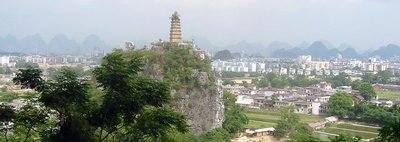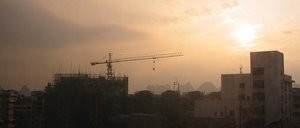Guilin
|
|
Elephant_trunk_hill.JPG
Guilin (Template:Zh-cp; Postal System Pinyin: Kweilin) is one of China's most picturesque cities, situated northeast of the Guangxi Zhuang Autonomous Region of the People's Republic of China on the west bank of the Lijiang River (also called the Li River).
| Contents |
History
In 314 BC, a small settlement was established along the banks of the Li River.
In 111 BC, during the reign of Emperor Wu of the Han Dynasty, Shi An County was established, which could be regarded as the beginning of the city.
In 507 AD, the town was renamed Guizhou.
Guilin prospered in the Tang and Song Dynasties but remained a county. The city was also a nexus between the central government and the southwest border, and it was where regular armies were placed to guard that border. Canals were built through the city so that food supplies could be directly transported from the food-productive Yangtze plain to the farthest southwestern point of the empire.
During the Ming Dynasty, Guilin became the capital of Guangxi, due to its immense role in the province.
In 1914, Nanning, another center of the province and a heroic city with more than 1,600 years of history, replaced Guilin as the provincial capital.
In 1921, Guilin became one of the headquarters of the Northern Expeditionary Army led by Dr. Sun Yat-sen.
In 1940, the city acquired its present name. In 1981, this ancient city was listed by the State Council as one of the four cities (the other three being Beijing, Hangzhou and Suzhou) where the protection of historical and cultural heritage, as well as natural scenery, should be treated as a priority project.
Physical Setting
- Area: 27,809 km²
- Subtropical region
- Typical karst formation
- Mountains: Diecai Hill, Elephant Trunk Hill, Seven-Star Cave, Wave-Subduing Hill, Lipu Mountain and Yaoshan Mountain
- Rivers: Li
People
- Population: 1.34 million
- Urban population: 600,000
- Ethnic groups: Zhuang, Yao, Hui, Miao, Han and Dong
Climate
- Damp monsoon climate
- Warm and rainy
- Plenty of sunshine and clear division of the four seasons
- Average temperature: 19°C annually
Economy
- The GDP per capita was ¥15775 (ca. US$1910) in 2003, ranked no. 125 among 659 Chinese cities.
- Local industry: pharmaceutical goods, tires, machinery, fertilizer, silk, perfume, wine, tea, cinnamon, herbal medicine
- Local produces: Shatian Pomelo, summer orange, fructus momordicae, ginkgo, moon persimmon, Lipu Tara, Sanhua Alcohol, pepper sauce, fermented bean curd, Guilin Rice Noodle, water chestnut, grain, fish and dried bean milk cream in tight rolls
Colleges and Universities
[Public]
- Guangxi Normal University(广西师范大学)
- Guilin Medical College (桂林医学院)
- Guilin Institute of Technology (桂林工学院)
- Guilin University of Electronic Technology (桂林电子工业学院)
Note: Institutions without full-time bachelor programs are not listed.
Attractions
The Jingjiang Princes City is a royal complex dating from the Ming Dynasty that lies near the center of modern Guilin.
Other scenic spots around Guilin include:
- Seven Star Park
- Seven-Star Cave and Ludi (Reed-Flute) Cave
- Camel Mountain and Elephant Trunk Hill
- Piled Festoon Hill
- Crescent Hill
- Fubo Hill
- Nanxi Hill
- Erlang Gorge
- Huangbu (Yellow Cloth) Beach
- Moon Hill
Quotes
- "I often sent pictures of the hills of Guilin which I painted to friends back home, but few believed what they saw."
- - Fan Chengda (Chinese Song Dynasty scholar)
- 桂林山水甲天下 "Guilin’s scenery bests all others in the world."
- - popular Chinese saying
Related articles
Guilin Dining
Guilin cuisine is typified by its sweetness and delicate use of spice and chili. It is a good especially place to taste snack food. Bamboo leaves stuffed with sweet rice and rice noodles are the two great snacks available all over Guilin.
External links
- The relative location of Guilin in China (http://www.citscanada.com/images/map-china.gif)
- China Planner (http://www.chinaplanner.com/index.htm) (a very informative site for those interested in visiting China)
- The Clintons in Guilin (http://www.chinavista.com/travel/guilin/clinton1.html)
- Guilin Travel Guide (http://www.guilinchina.net)
- Guilin cuisine is typified by its sweetness and delicate use of spice and chili. (http://www.china-tour.cn/cityguides/Guilin_Dinning.htm)
- Guilin Tours (http://www.chinahighlights.com/guilin/tours.htm)
- Guilin Tour (http://www.beijingservice.com/guilintour.htm)


